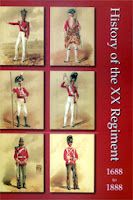
This post will look at army service numbers and the dates on which these were issued to men joining the regular (1st and 2nd) Battalions of the Queen's Royal West Surrey Regiment. The period covered in this post is July 1881 to July 1914.
The Queen's (Royal West Surrey) Regiment was formed on 1st July 1881 out of the old 2nd (The Queen's Royal) Regiment of Foot. What follows should be considered a snapshot of army service numbers and joining dates for Queen's regulars - one date and one number per year from 1881 until 1914. Service records for all of the numbers listed below, survive in WO 363 (Burnt Documents) and WO 364 (Pensions) in the National Archives and can also be viewed on-line via the Ancestry.co.uk website.
Findmypast has over 33,000 Queen's (Royal West Surrey) army service records. Click on the link to see the results.
Here are the Queen's (Royal West Surrey) regimental numbers:
157 joined on 1st December 1881
283 joined on 27th February 1882
413 joined on 17th February 1883
940 joined on 5th July 1884
1266 joined on 22nd June 1885
1724 joined on 19th August 1886
1934 joined on 28th July 1887
2214 joined on 24th January 1888
2639 joined on 20th February 1889
2926 joined on 25th February 1890
3451 joined on 19th February 1891
3795 joined on 1st February 1892
4258 joined on 10th August 1893
4447 joined on 25th June 1894
4722 joined on 10th January 1895
4994 joined on 15th June 1896
5307 joined on 10th May 1897
5669 joined on 8th June 1898
6120 joined on 12th October 1899
6440 joined on 26th April 1900
6833 joined on 18th July 1901
7132 joined on 5th June 1902
7707 joined on 6th January 1903
8001 joined on 21st January 1904
8566 joined on 4th September 1905
8823 joined on 7th March 1906
9019 joined on 5th March 1907
9439 joined on 8th September 1908
9505 joined on 27th January 1909
9778 joined on 11th October 1910
9822 joined on 12th January 1911
10102 joined on 5th February 1912
10330 joined on 23rd January 1913
10641 joined on 27th July 1914
When Britain went to war with Germany a week later, the number series above was continued for men enlisting with the Queen's under regular enlistment terms of service. Recruits to the service battalions, joining up for war-time service only, were given numbers from a new series which began with the number 1 and was prefixed with the letter G/.
The L/ prefix - which appears to have been inconsistently used for regular enlistments up until August 1914, continued to be used (inconsistently) for men enlisting for regular service from August 1914.
I also offer a comprehensive, fast and cost-effective military history research service. Follow the link for more information.
From The Naval & Military Press:

History of The Queen's (Royal West Surrey) Regiment in the Great War
Despite the fact that the book gets off to the worst possible start by placing the brackets on the cover in the wrong place - it's Queen's (Royal West Surrey) Regiment , not Queen's Royal (West Surrey) Regiment - this is good account of the regiment during the First World War. Click on the image above to read the Naval & Military Press blurb.


















.jpg)

